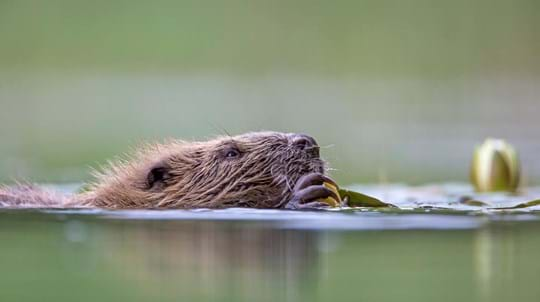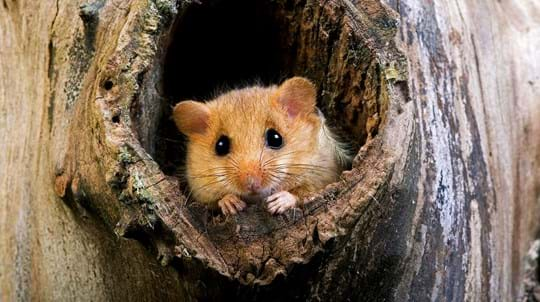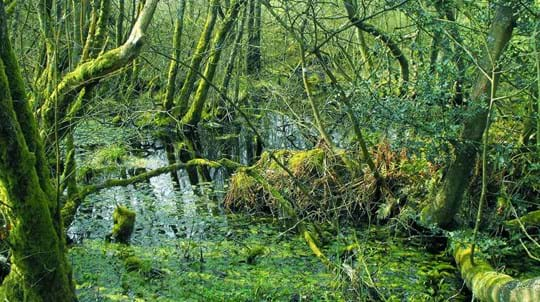
Credit: Blickwinkel / Alamy Stock Photo
What do beavers eat?
Beavers are herbivores and do not eat fish as commonly thought. Their diet is made up of aquatic plants and grasses, as well as the bark, twigs and leaves of trees.
Architects of the animal world, beavers are back in the UK’s rivers after centuries away. These dam-building rodents can transform their local environment by creating new wetland habitats.
Common names: beaver, Eurasian beaver
Scientific name: Castor fiber
Family: Castoridae
Habitat: streams, rivers and lakes next to woodland
Diet: aquatic plants, tree bark and leaves
Predators: adults have no natural predators
Origin: native
Beavers look like no other British mammal. They have brown fur, a flat, broad tail and huge orange teeth. One of the largest members of the rodent family, beavers can weigh as much as 30kg and measure well over a metre from head to tail.

Credit: Blickwinkel / Alamy Stock Photo
Beavers are herbivores and do not eat fish as commonly thought. Their diet is made up of aquatic plants and grasses, as well as the bark, twigs and leaves of trees.
Beavers live in small family groups and are thought to mate for life. Typically, two to four young, known as kits, are born each year. Youngsters stay with their family for around two years before leaving to find territories of their own. Beavers live for around seven to eight years.
Beaver lodges are often built with a type of ‘chimney’ to regulate temperature.
Knapdale, the Tay and the Otter are the only places in the UK with wild, free-ranging beavers. The species has also been introduced to Kent, Essex and the Forest of Dean, but these populations are kept in large, fenced enclosures. The impact of these enclosed beavers is being monitored, with hopes they will reduce flood risk and boost biodiversity.
Beavers were originally hunted to extinction in the UK around 500 years ago. In 2009, the Scottish Government approved a trial reintroduction at Knapdale, Argyll. However, these were not the first beavers to return. A few years earlier, beavers were discovered on the River Tay, having either escaped from captivity or been illegally released. In 2010, a similar situation occurred on the River Otter in Devon, with a population of unknown origin discovered.
Beavers build dams to restrict water flow and create ponds of still, deep water. Within these ponds they construct lodges in which they live, safe from predators. Beavers use their huge teeth to fell trees and divide them up into smaller branches, which are dragged into place to build the dams. Lodges are made of sticks and branches held together with mud, which also provides insulation.

Credit: Anne Marie Kalus / WTML
Fresh water surrounded by woodland is ideal beaver habitat, providing both food and shelter. The rodents are crepuscular, meaning they are most active at dawn and dusk. To be in with a chance of seeing one, visit an area where beavers are known to be present. Quietly watch the water and listen out for any splashing or gnawing sounds. It’s much easier to see signs of beaver activity than to spot the animal itself. Felled trees, stripped branches, dams and lodges are all evidence that beavers are active in an area.
Beavers can hold their breath for up to 15 minutes.
The UK beaver population has been estimated at more than 400 animals. The Scottish Government has formally recognised beavers as a native species, meaning it is here to stay. However, beavers are yet to receive legal protection and can be culled by landowners without regulation.
In 2020, following a 5-year reintroduction trial, it was announced beavers would be allowed to stay at their new home in the River Otter in Devon.
The presence of beavers can deliver a wide range of advantages. By building dams they create new wetland habitats that benefit a host of other species ranging from fish to fungi. Dams can also reduce flood risk, increase water storage and improve water quality. However, mitigation measures may be required to limit any negative impacts on agricultural land.
As rodents, beavers are related to rats and mice, but are much larger. An adult beaver can weigh as much as 1,500 house mice!

Blog
Karen Hornigold • 29 Jan 2019

Trees woods and wildlife
Trees and woods provide a stable habitat and food supply for many mammals. What will you spot?

Trees woods and wildlife
Wild, transient, boggy and rare. Wet woodlands are now some of our least common wooded habitats. Learn about these special places and why they are so important to wildlife.

Woodland wildlife is fading before our eyes. Please support our appeal to save rare and threatened species.
Donate now